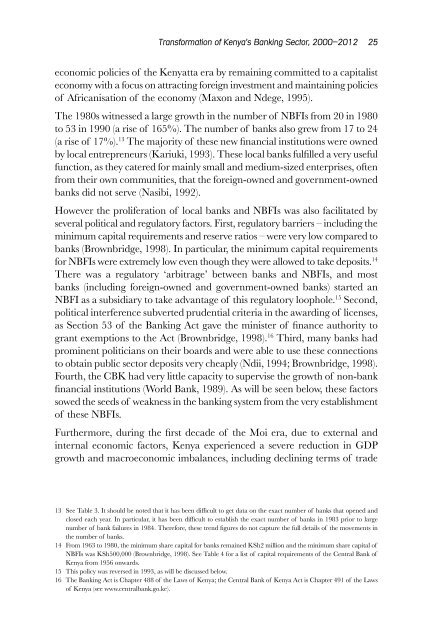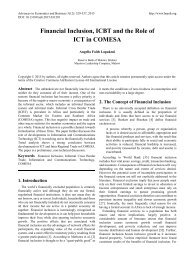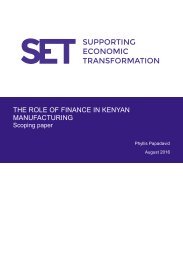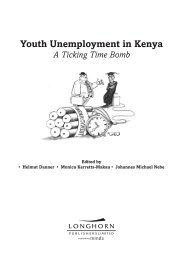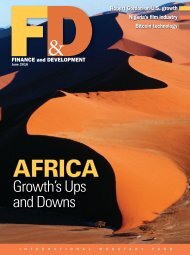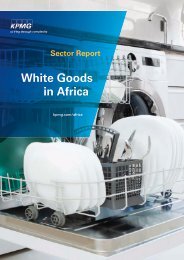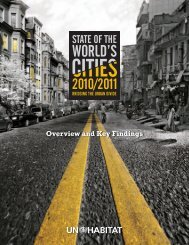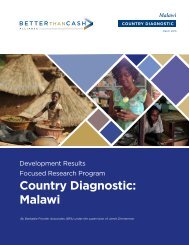in the 21st Century
hTOE305aYVW
hTOE305aYVW
You also want an ePaper? Increase the reach of your titles
YUMPU automatically turns print PDFs into web optimized ePapers that Google loves.
Transformation of Kenya’s Bank<strong>in</strong>g Sector, 2000–2012 25<br />
economic policies of <strong>the</strong> Kenyatta era by rema<strong>in</strong><strong>in</strong>g committed to a capitalist<br />
economy with a focus on attract<strong>in</strong>g foreign <strong>in</strong>vestment and ma<strong>in</strong>ta<strong>in</strong><strong>in</strong>g policies<br />
of Africanisation of <strong>the</strong> economy (Maxon and Ndege, 1995).<br />
The 1980s witnessed a large growth <strong>in</strong> <strong>the</strong> number of NBFIs from 20 <strong>in</strong> 1980<br />
to 53 <strong>in</strong> 1990 (a rise of 165%). The number of banks also grew from 17 to 24<br />
(a rise of 17%). 13 The majority of <strong>the</strong>se new f<strong>in</strong>ancial <strong>in</strong>stitutions were owned<br />
by local entrepreneurs (Kariuki, 1993). These local banks fulfilled a very useful<br />
function, as <strong>the</strong>y catered for ma<strong>in</strong>ly small and medium-sized enterprises, often<br />
from <strong>the</strong>ir own communities, that <strong>the</strong> foreign-owned and government-owned<br />
banks did not serve (Nasibi, 1992).<br />
However <strong>the</strong> proliferation of local banks and NBFIs was also facilitated by<br />
several political and regulatory factors. First, regulatory barriers – <strong>in</strong>clud<strong>in</strong>g <strong>the</strong><br />
m<strong>in</strong>imum capital requirements and reserve ratios – were very low compared to<br />
banks (Brownbridge, 1998). In particular, <strong>the</strong> m<strong>in</strong>imum capital requirements<br />
for NBFIs were extremely low even though <strong>the</strong>y were allowed to take deposits. 14<br />
There was a regulatory ‘arbitrage’ between banks and NBFIs, and most<br />
banks (<strong>in</strong>clud<strong>in</strong>g foreign-owned and government-owned banks) started an<br />
NBFI as a subsidiary to take advantage of this regulatory loophole. 15 Second,<br />
political <strong>in</strong>terference subverted prudential criteria <strong>in</strong> <strong>the</strong> award<strong>in</strong>g of licenses,<br />
as Section 53 of <strong>the</strong> Bank<strong>in</strong>g Act gave <strong>the</strong> m<strong>in</strong>ister of f<strong>in</strong>ance authority to<br />
grant exemptions to <strong>the</strong> Act (Brownbridge, 1998). 16 Third, many banks had<br />
prom<strong>in</strong>ent politicians on <strong>the</strong>ir boards and were able to use <strong>the</strong>se connections<br />
to obta<strong>in</strong> public sector deposits very cheaply (Ndii, 1994; Brownbridge, 1998).<br />
Fourth, <strong>the</strong> CBK had very little capacity to supervise <strong>the</strong> growth of non-bank<br />
f<strong>in</strong>ancial <strong>in</strong>stitutions (World Bank, 1989). As will be seen below, <strong>the</strong>se factors<br />
sowed <strong>the</strong> seeds of weakness <strong>in</strong> <strong>the</strong> bank<strong>in</strong>g system from <strong>the</strong> very establishment<br />
of <strong>the</strong>se NBFIs.<br />
Fur<strong>the</strong>rmore, dur<strong>in</strong>g <strong>the</strong> first decade of <strong>the</strong> Moi era, due to external and<br />
<strong>in</strong>ternal economic factors, Kenya experienced a severe reduction <strong>in</strong> GDP<br />
growth and macroeconomic imbalances, <strong>in</strong>clud<strong>in</strong>g decl<strong>in</strong><strong>in</strong>g terms of trade<br />
13 See Table 3. It should be noted that it has been difficult to get data on <strong>the</strong> exact number of banks that opened and<br />
closed each year. In particular, it has been difficult to establish <strong>the</strong> exact number of banks <strong>in</strong> 1983 prior to large<br />
number of bank failures <strong>in</strong> 1984. Therefore, <strong>the</strong>se trend figures do not capture <strong>the</strong> full details of <strong>the</strong> movements <strong>in</strong><br />
<strong>the</strong> number of banks.<br />
14 From 1963 to 1980, <strong>the</strong> m<strong>in</strong>imum share capital for banks rema<strong>in</strong>ed KSh2 million and <strong>the</strong> m<strong>in</strong>imum share capital of<br />
NBFIs was KSh500,000 (Brownbridge, 1998). See Table 4 for a list of capital requirements of <strong>the</strong> Central Bank of<br />
Kenya from 1956 onwards.<br />
15 This policy was reversed <strong>in</strong> 1993, as will be discussed below.<br />
16 The Bank<strong>in</strong>g Act is Chapter 488 of <strong>the</strong> Laws of Kenya; <strong>the</strong> Central Bank of Kenya Act is Chapter 491 of <strong>the</strong> Laws<br />
of Kenya (see www.centralbank.go.ke).


